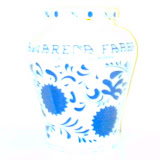Sesame Halva
a flaky confection of crushed sesame seeds, nuts and sugar
Eclectic Recipes has details, and variations.
Flavourings
Halva, or halvah, can carry all sorts of flavours: cardamon, rose water, vanilla, coffee, chocolate, etc. Experiment!
Some flavourings — such as cardamon and rose water — should be added just before you stop boiling the syrup, so you don't lose all the essential aromas to the atmosphere.
- Ingredients
- 280g sugar
- 100ml water
- flavourings
- 340g tahini
beaten to mix in any excess oil
Boil the sugar and water with flavourings to 125 °C (257 °F, somewhere between ``hard ball'' and ``small crack'' syrup).
Hazelnuts and (unsalted) pistachios can be roasted then rubbed in a teatowel to remove their skins.
At this stage you can add nuts (pistachio, almond, hazelnut). It's worth the effort to blanch almonds then gently toast the nuts in a moderate oven (180 °C - 355 °F). Add as many as you want—this mixture will easily take 250g of nuts if you like your halva that way; shop-bought halva has far less.
Gradually add the flavoured sugar syrup to the tahini, beating all the while.
Beat the mixture well as you add syrup to sesame, and continue beating once all is combined, until the mixture begins to set. This promotes formation of sugar crystals (as in fudge making), which give your halva the flaky character it should have.
Press the mixture into an oiled cake tin (either with a press-out base, or lined with baking paper) or plastic container, and leave in the fridge for 36 hours. Cut while cold, with a sharp knife (if the halva is softer than the nuts it's difficult to make a clean cut).
I used to have here a halva recipe from Peter Conistis, Eleni's, Sydney. This called for eggwhite—something not listed as an ingredient of any commercial halva I have bought. However, most commercial halvas list nutrients in various languages—including German. The nutrients include protein (in German, Eiweiss).
The Conistis recipe gave a fudge-like halva, never quite as flaky as the store-bought variety. Using the tahini from my local store, which comes in 340g jars, the recipe here (52% tahini, 43% sugar, 5% water) gives halva with 12% protein, 30% fat, 46% carbohydrate, and around 500kCal per 100g—which matches pretty well the composition of store-bought halva.
Halva from Tadjikistan includes both soft and solid varieties, with eggwhites in the soft version. Some of the Tadjiki Halva (or Khalva) recipes there also include soap root. This may be soapwort (Bouncing Betty, or saponaria), or maybe Baby's Breath (Gypsophila Struthium).






4 comments:
Fantastic recipe variety and disambiguation. A rare gem. Great blog, too. Keep up the good work.
I've been looking for a recipe and this one seems grea t- I will let you know if it tastes like the great ones I just had in Israel and Greece! Thanks!
When you say that we can use different flavourings do you mean a liquid flavouring essence or the real thing. For example, if I want to make a chocolate halva, should I use chocolate liquid flavouring or a real chocolate? If it is real chocolate, how much can I put in without spoiling the texture of the halva?
This recipe works extremely well. Have tried some different ones. It is very light and flaky, sets up quickly.
We needed to prepare a halvah ice cream for an event, the client was very allergic to nuts, so it was made from scratch.
Post a Comment